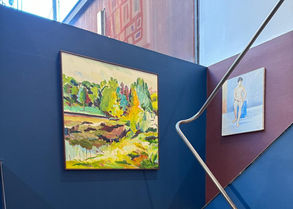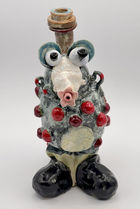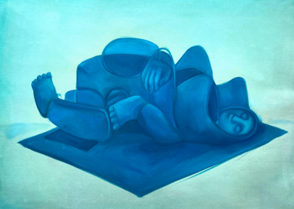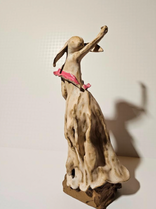A Recipe for the Perfect Art Fair
- AHA FIne Art

- Apr 3, 2017
- 4 min read
All the things the Art on Paper Fair does right
Big Names and New Discoveries
Art on Paper had plenty of recognizable names on offer: author and artist Dave Eggers’ humorous sketches of animals at Electric Works, as well as Barnaby Whitfield and William Powhida at Gallery Poulsen. But I’ve always relished discovering new artists at the fair, and this year I wasn’t disappointed. Josephine Taylor’s pastel-colored paintings of nudes at Catharine Clark Gallery were entrancing, and Rachel Grobstein’s miniature paintings mounted on pins played tricks on the eye at AHA Fine Art.

Rachel Grobstein at AHA Fine Art.
Alanna Martinez

A close of Rachel Grobstein’s Ajax, 2015-16.
Alanna Martinez
All the things the Art on Paper Fair does right
Another year, another Armory Week and again I find myself at the same conclusion: I just love the Art on Paper fair so much. Despite the inevitable swollen feet and exhaustion that will come to a head by Sunday evening, I honestly look forward to frenzied madness of the New York art world’s spring awakening. It’s a time when the city’s creative class comes out of hibernation to socialize and show off its latest wares in a week-long ceremony that looks forward to the promise of the warmer seasons’ openings, parties and general hubbub. The week’s grand dame, the Armory Show, routinely provides a drool worthy selection of masterpieces I’ll never be able to own. At the Independent, dealers manage to pull of museum-quality presentations in pop-up form. And the SPRING/BREAK fair is always guaranteed to serve up a crash course in the who’s who of the downtown scene and takes fairgoers urban spelunking through some of New York’s most unusual spaces. But the Art on Paper fair, one of the week’s rare themed events, has for the past three years beat out the competition at providing both a healthy range of price points and a genuinely pleasant viewing experience for art. It’s become my Armory Week sanctuary.
The team behind Art on Paper, Jeffrey Wainhouse and Max Fishko of Art Market Productions, have art fairs down to a science, which is perhaps why their roster of prestigious fairs— which includes Miami Project, the Seattle Art Fair, and Market Art+Design to name a few—continues to grow. But Art on Paper, with its unique and loose “paper” theme, stands out. And so, here are all the things I loved about this year’s Art on Paper fair, in no particular order:
Spacious Viewing Space can come at a pricey premium at fairs, but at Art on Paper dealers and art alike have plenty of room to spare. While the fair’s venue, Pier 36, is a bit of a hike from the nearest bus or subway, it’s airy, has plenty of natural light, and don’t laugh at me but the bathrooms are incredible and spotless. And every so many feet organizers provide benches or standing tables for fairgoers to rest their legs or organize the many leaflets they’ve collected along the way.
Booths that benefitted from the extra legroom were Brooklyn’s Space 776, which brought work by a single artist named Jungsan Kim Yun-sik. The Korean artist’s large scale works feature fragments of poetry painted onto long sections of folded and framed scrolls and matchbook-sized blocks, arranged so that from afar the text forms soft geometric patterns. Meanwhile, Center Street Studio showed Brian Andrew Whitely’s now-infamous Trump Legacy Stone, a monument that he originally planted anonymously in Central Park as part of a guerrilla art project. Along with the headstone, the gallery sold and made on-site rubbings from the monument’s engraving, which reads: “Trump, Donald J., 1946-, Made America Hate Again.”
Ambitious Installations Tahiti Pehrson’s soaring installation The Fates greeted visitors at the fair’s entrance, and was comprised of three 17-foot-tall boxy paper towers illuminated from above and cut with intricate swirling designs based on the Fibonacci sequence. The work was created for Pehrson’s residency with Viacom, and it was first shown at the company’s Times Square offices.
Also at the front was Timothy Paul Myers’ life-sized, gray felt installation The Living Room, shown by Walter Maciel Gallery. The sculpture featured all the trappings of a domestic interior in monochromatic form—a comfy chair, framed pictures on a fireplace mantle, and stacks of books on the floor—but Myers disrupts the scene with an eruption of floral forms that spill forth from the hearth.
Varied Price Range At Philadelphia’s Paradigm Gallery I stumbled upon Alex Eckman-Lawn’s cut paper collages. The pieces, which started at $250, feature meticulous renderings of human anatomy, organic plants and animals, layered in shadow boxes to create compact vignettes with macabre underlying themes. Eckman-Lawn also works as an illustrator and creates comics, and was among my favorite affordable discoveries at this year’s fair.
Copenhagen’s Gallery Poulsen brought work by New York-based artist Mi Ju, whose incredible paintings filled with enormous worlds populated by tiny fantastical characters I’ve previously written about for Observer. Her paintings blue-hued Fishing Dreams and Sleepwalker were going for $16,000 a piece.
A Little Something for Everyone Japanese and East Asian specialists Ronin Gallery brought a mix of contemporary and historic Ukiyo-e prints, but it was the prints by Japanese artist Hideo Takeda (a cartoonist who was given a rare solo exhibition at the British Museum in the 1990s) that caught my eye. On the other end of the fair, photographer works from Kris Graves’s The Testament Project were on view at Sasha Wolf Projects’ booth. Graves describes the project on his website as “an exploration and re-conception of the contemporary black experience in America.” A wall of portraits lined the booth, each one saturated in a completely unique combination of vibrant hues.
A Great Theme Art on Paper’s greatest strength is its theme, which is interpreted literally by some dealers who lean heavily toward showing prints and drawings, and more loosely by others like artist Peter Sarkisian, whose projected animations onto books and paper. In the instance of Dublin-based artist Anita Groener, whose works were shown by Gibbons and Nicholas, the medium was an effective platform for exploring the timely subject of migration, in this case, Europe’s refugee crisis. Using a digital paper-cutter, Groener produces tiny cut-outs of refugees based on real photographs, some caring luggage and others sparring with police. The figures are glued to pins and affixed to the wall, appearing like abstract dark marks from afar but revealing their individual stories upon closer inspection.
By Alanna Martinez - http://observer.com/2017/03/art-on-paper-fair-photos-report-best-galleries-booths/































Comments